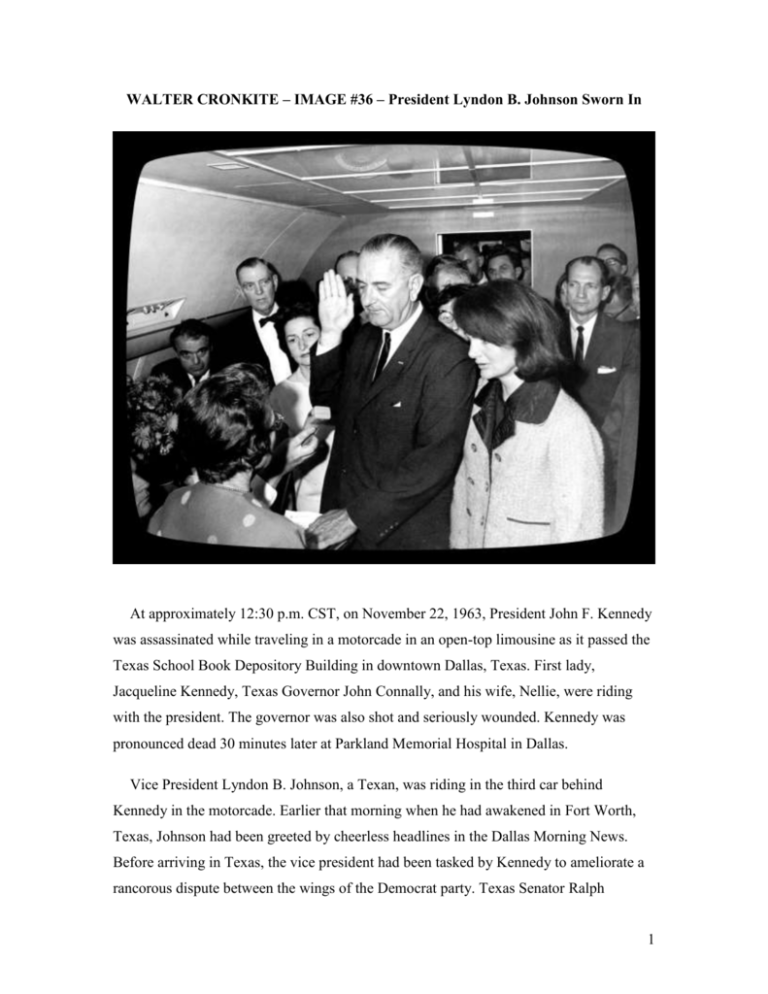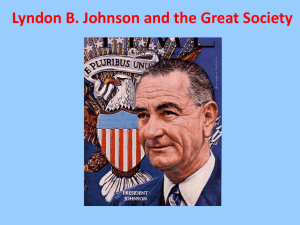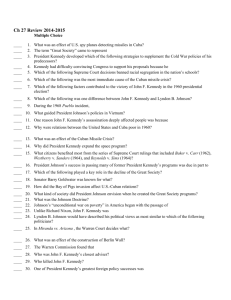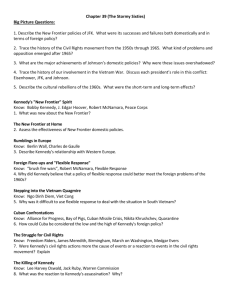docx - Missouri Western State University
advertisement

WALTER CRONKITE – IMAGE #36 – President Lyndon B. Johnson Sworn In At approximately 12:30 p.m. CST, on November 22, 1963, President John F. Kennedy was assassinated while traveling in a motorcade in an open-top limousine as it passed the Texas School Book Depository Building in downtown Dallas, Texas. First lady, Jacqueline Kennedy, Texas Governor John Connally, and his wife, Nellie, were riding with the president. The governor was also shot and seriously wounded. Kennedy was pronounced dead 30 minutes later at Parkland Memorial Hospital in Dallas. Vice President Lyndon B. Johnson, a Texan, was riding in the third car behind Kennedy in the motorcade. Earlier that morning when he had awakened in Fort Worth, Texas, Johnson had been greeted by cheerless headlines in the Dallas Morning News. Before arriving in Texas, the vice president had been tasked by Kennedy to ameliorate a rancorous dispute between the wings of the Democrat party. Texas Senator Ralph 1 Yarborough, a liberal leader in the party, had the day before very publicly thumbed his nose at Johnson, the would-be mediator. The humiliation was well documented in the newspapers that morning, and the stories were indicative of where Johnson was in his political career that day. All was not well, was he politically washed up? Would President Kennedy toss him off the 1964 ticket, as was rumored? How it would end, even this master politician could not foretell. Meanwhile, back in Washington, D.C., a potential scandal for Johnson was slowly building as the Senate rules committee looked into the activities of Robert G. “Bobby” Baker, who had served at Johnson’s appointment as secretary for the Democrat majority during Johnson’s days in the Senate. Known as “Little Lyndon,” Baker had resigned under pressure from the probe. But the scandal was growing, and it threatened to embroil Baker’s former boss – LBJ. Life magazine had chronicled the scandal and, unlike prior press coverage, tied the mess directly to Johnson. The magazine had bigger targets in mind, as well. That very morning editors and reporters were meeting to discuss angles for a broader investigation – this one into the vice president’s personal finances. When shots rained down on the president’s motorcade in Dallas, Johnson, who had gained a reputation in college for being “an absolute physical coward,” was entirely still against the floor of his car as Secret Service agent Rufus Youngblood shielded him with his body. The agent later summed up the vice president’s demeanor as “calm.” Despite the wail of police sirens and the rush of Secret Service precautions, and his own uncertain political future, Johnson’s tone was measured when told that agents would be rushing him to safety. As Youngblood gave him his instructions, Johnson said, “OK, pardner, I understand.” Crushed against the floor of his limousine by the weight of the Secret Service agent, Johnson was driven quickly to the emergency room entrance of the Parkland Memorial Hospital, where he was hurried through the halls until agents could find a room to secure. Once she and her husband were deposited in a small, bare room, Lady Bird Johnson recounted that everything grew suddenly still. Johnson stood with his back against a wall and gave instructions for Texas congressmen and aides whose fidelity was unquestioned 2 to be brought to him. Then, he and his wife did little more than stare. Lady Bird recalled that “Lyndon and I didn’t speak. We just looked at each other exchanging messages with our eyes.” Even with the president dead, speculation about a wider plot was rampant, and no one could be sure that the worst had yet come. After leaving the hospital, Johnson was taken to Air Force One at Love Field in Dallas, where he took refuge in the presidential bedroom. With the Secret Service agents outside still concerned that a conspiracy might be afoot, Johnson placed a call to Attorney General Robert Kennedy. The choice of the recently assassinated president’s brother and confidante as Johnson’s first call was motivated in part by common sense legal concerns and political considerations, but also in part by a desire to be legitimated by the Kennedy clan. Johnson knew that Robert Kennedy was the one man whose approval would carry the most weight. This call, and another that followed it, soon after, became a matter of dispute in later years as the two politicians clashed over the events of the day. In question was Johnson’s decision to be sworn in immediately on the plane in Dallas, an action that the grief-stricken Kennedy later recounted he did not think was necessary. Kenneth O’Donnell, a special assistant to President Kennedy, recounted that Johnson claimed “he’d talked to Bobby and that Bobby told him to be sworn in right there.” Robert Kennedy later contradicted this conclusion. In Johnson’s version of the story, all he wanted from the attorney general was the text of the oath of office, wording that he could have retrieved from any number of other sources. Whatever Robert Kennedy’s personal feelings about Johnson – and they were never very good – the new president got what he wanted. The fallout from those calls, however, only deepened the mutual animosity between the two men, which became “perhaps the greatest blood feud of American politics in the 20th century.” Johnson wanted, and in some ways needed, the first lady present when he was sworn in as president. Youngblood, his Secret Service agent, later claimed that Johnson was “adamant” that Mrs. Kennedy and the remains of her husband accompany Johnson on the airplane. Jacqueline Kennedy had presided over Camelot in her signature pillbox hat, and, now, in a pink dress that belied the tragedy of the day, she was the nation’s chief mourner. 3 Mrs. Kennedy’s gentle voice was edged with steely reserve when she told Lady Bird that she was not yet ready to change out of her bloodstained clothes because she wanted “them to see what they have done to Jack.” As four seats were removed from the plane’s rear compartment to make way for her husband’s bronze coffin, Jackie Kennedy stepped past it and entered the bedroom to find Johnson either, as different accounts have it, reclining in his shirt sleeves or about to exit the room. Either way, Johnson scored another coup. According to O’Donnell, when he personally asked Mrs. Kennedy about whether she should be at the ceremony, she said, “Yes. I think I ought to. At least I owe that much to the country.” Whether Mrs. Kennedy agreed explicitly or not, she and Johnson understood that, when he took the oath, she would be present. The widow of the murdered president was not the only person Johnson needed present when he took the oath. He had arranged his life around the wielding and manipulation of power. He knew that, as a president chosen not by the people but by an assassin’s bullet, he needed to create a scene that would confer legitimacy on his presidency from its very beginning. Reporters were a crucial part of that scene. Charles Roberts of Newsweek was joined on the plane by Merriman Smith of UPI and Sid Davis of Westinghouse Broadcasting. Johnson packed the cramped, hot conference room aboard Air Force One, where he took the oath, with the deceased president’s aides, including Malcolm Kilduff, JFK’s assistant White House press secretary. Standing alongside Johnson were his wife and Mrs. Kennedy. Slightly behind him stood two Texas congressmen, Albert Thomas and Jack Brooks, along with Jack Valenti, the longtime president of the Motion Picture Association of America. Kilduff, who earlier had made the public announcement of the death of President Kennedy, held up a Dictaphone and made the only audio recording of this presidential oath of office. Sarah T. Hughes, U.S. District Judge of the Northern District of Texas, administered the oath to a grim-faced Johnson at 1:38 p.m. CST, as he made the transition from vice president to president. After he was sworn in as the 36th President of the United States and photographs were taken, Johnson did not hesitate. He said, “Now let’s get airborne.” Roberts of Newsweek described Johnson as “far from being crude and inconsiderate” 4 and “as thoughtful, cool, and compassionate” after the assassination. Hughes, who swore in Johnson as president, stated that his behavior was exemplary. In many ways, LBJ was the opposite of JFK. A fourth-generation Texan, who liked to refer to himself as “the last Frontiersman, Johnson was a seasoned Texas politician and longtime Senate leader, who was most at home in the back rooms of power broking. He was a rough-edged character who had scrambled his way up, without too many scruples, to wealth and political eminence. But he never forgot his modest, hill-country origins, nor did he lose his sympathy for the downtrodden. Johnson lacked Kennedy’s style, but he capitalized on Kennedy’s assassination, applying his astonishing energy and negotiating skills to bring to fruition several of Kennedy’s stalled programs, and many more of his own, in the Great Society. Johnson was an ambitious leader, whose vision was a New Deal for a new era. As president, he harnessed his considerable political skills in an effort to make the vision a reality. Eventually, however, American involvement in the Vietnam War led to political wounds for LBJ, which sapped his spirit and from which his presidency never recovered. 5




